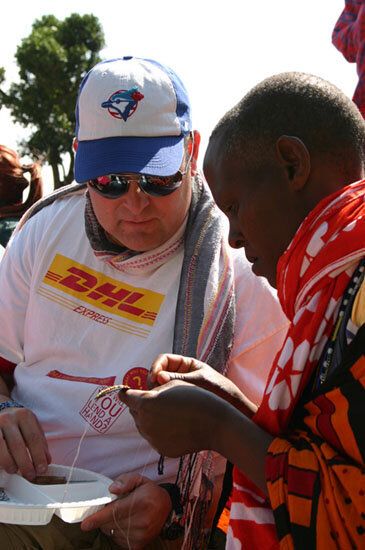"If you want to go fast, go alone. If you want to go far, go together." (African proverb). Having spent 10 days in Kenya this summer, this proverb has never rung more true. In the spirit of volunteerism that our organization celebrates every year with Global Volunteer Day, I travelled to Kenya to celebrate the one year anniversary of our partnership with the globally-recognized charity, Free The Children.
While in Africa we were received by the village elders, who bestowed a blessing on us and our staff. This blessing, along with the work we set out to do, affirmed the importance of our partnership for me, because I saw firsthand the direct impact of how we are helping these communities and making a real difference.
We first spent time helping lay concrete foundation for a new high school for girls, an institution that will help bring higher education to their village, allowing them to further improve their lives and those of their families. One of the most effective ways to fight poverty and bolster poor communities is through investing in education. However, today more than 75 million primary school-age children are not in school. More than half of these children are girls, and 75 per cent of them live in sub-Saharan Africa and South Asia.

Speaking with the girls, I learned about their ambitions and dreams and how some of them hope to be the first in their families to graduate high school. I will never forget how one student, a young girl named Ruth, took my hand and told me that she was the first of seven children in her family to go to high school and how she dreamed of one day becoming a lawyer. By helping lay the new foundation of the school, our group of volunteers truly took another step in fostering economic growth and stability through the power of education.

I also visited the Baraka Medical Clinic and Medicinal Garden that serves over 40,000 community members through preventative, curative and rehabilitative services. The Baraka clinic delivers medical supplies to this large community that had no access to modern healthcare before the clinic was founded.
Finally, I had the opportunity to help fetch water and bead jewelry with the Massai Mamas (the "Mamas") to learn more about the daily lives of Massai and Kipsigis communities. Speaking with the Mamas, I learned how participating in these tasks provided them with a sense of empowerment and gratitude as it helped them support their families. Studies have indicated that when women hold assets or gain income, the money is more likely to be spent on nutrition, medicine and housing, and consequently their children are healthier. For every dollar a woman earns, she invests 80 cents in her family. Hearing the Mamas' gratitude and their pride had a profound impact on me, and their entrepreneurial spirit will continue to be an inspiration to me.

Perhaps the biggest learning I took away from my time in Kenya is that effective corporate social responsibility initiatives are about more than simply writing a cheque and signing on the dotted line. Rather, it is about working together and providing expertise and opportunities to create solutions that will help communities thrive. Additionally, organizations - whether philanthropic or corporate - need to ensure that the platforms for these crucial issues are strong and sustainable on their own. While outside aid and support is important, permanent change takes root and grows exponentially faster and more successfully when it is anchored in the communities themselves.
Canadians give billions of dollars to charities every year. According to the most recent Statistics Canada and the Canada Survey of Giving, Volunteering and Participating (CSGVP), Canadians gave $10.6 billion to charities in 2010. While donating to charity is crucial, the role of corporate social responsibility has changed significantly. While it was once sufficient for companies to simply write a cheque to charities, we are now doing more. Companies are now calling on their employees to provide one-on-one activities. Today, there is a powerful surge to move toward a model of establishing partnerships focused on sharing the organization's expertise with the charity(ies) that they support along with the ability to create powerful platforms that reach across the globe.
When establishing a partnership with a charitable organization or not-for-profit, I've found these tips to be helpful:
- Focus. Find a meaningful way to help by offering services that your organization specializes in. Whether your speciality is in financial services, logistics or education, use that expertise to help establish a beneficial partnership where your skills are needed.
- Engage. Effective CSR can't come from just one person; it needs to be ingrained in the whole organization. Help build momentum and engagement by involving employees in the whole program. Engage employee with opportunities and encourage employees to the development and the success of the partnership. This way, not only will everyone feel connected to the cause, but they can each also bring their own expertise and experience to make a difference.
- Collaborate. Like the African proverb above stated, "if you want to go far, go together." Collaboration with other like-minded organizations and customers can provide the opportunity to build meaningful partnerships and a wider breadth of services and expertise to charities. By playing to each partner's strengths, collaborations can reach farther with a larger impact on more people.
- Follow through. Establishing a successful partnership can take persistence and efforts. Build the partnership over time and keep up momentum with employees, the community and the organization during and between big initiatives. You can do this through small ongoing volunteer programs or keeping employees updated on the status of the partnership and communicating personal stories and successes throughout the year. This will highlight to each employee why your initiative is important, how it is helping and why they should be proud to participate.